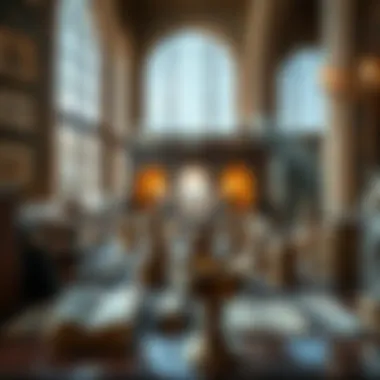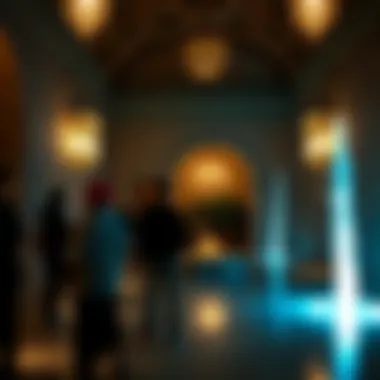Exploring Dubai's Oldest Building: A Heritage Insight


Intro
Dubai is often seen as a glitzy city, full of modern marvels and towering skyscrapers. However, hidden among its rapid development lies a gem that resonates with tales of the past: the oldest building in Dubai. This structure is not just a relic; it's a testament to the city's rich history and cultural heritage. Understanding this building leads to a deeper appreciation of Dubai's evolution from a small trading post to a global metropolis.
In this article, we explore the architectural significance of this historic site, its transformation over time, and the role it plays in the contemporary urban landscape. We'll examine preservation efforts that highlight the importance of keeping such landmarks alive, enabling both residents and tourists to connect with the roots of Dubai's identity.
Join us as we journey through the layers of history, examining how this building not only reflects the broader changes in Dubai but also enriches the lives of those who encounter it.
Prelims to Dubai's Historical Architecture
Dubai is often celebrated for its glitzy skyline and modern marvels, but this city's architectural identity is steeped in a rich historical narrative that deserves closer inspection. Understanding Dubai's historical architecture enriches our appreciation of urban development in this vibrant metropolis, shedding light on both its past and present.
Significance of Historical Buildings
Historical buildings are not merely remnants of the past; they are crucial markers that tell the story of a community’s evolution. They reveal the layers of cultural influence and societal change that have shaped the city. For investors and expatriates alike, these structures offer a glimpse into the traditional ways of life that contrast sharply with Dubai's contemporary lifestyle.
Many of Dubai's older architectural works exhibit distinctive designs that showcase the ingenuity of local craftsmanship. The preserved buildings play a role in fostering a sense of place and belonging for residents while also serving as a dynamic attraction for visitors. Without these landmarks, the narrative of Dubai’s rapid development might feel incomplete, lacking the depth that historical context provides.
Dubai's Architectural Journey
The architectural journey of Dubai is a fascinating tale of transformation. From humble fishing villages to an emerging global metropolis, each phase of its development has left an indelible mark on the cityscape. The transition from traditional coral stone constructions to the skyscrapers made of glass and steel has been stark. This evolution illustrates how Dubai has blended its rich cultural heritage with cutting-edge modernity.
In the early days, buildings were designed for functionality and sustainability, utilizing local materials to withstand the harsh desert climate. With time, influences from various cultures through trade and migration reshaped architectural styles, leading to a unique fusion that can be seen in structures across the city.
As Dubai continues to grow, understanding this architectural journey is vital. It provides valuable insights into how the city reconciles modern needs with its historical roots, making the exploration of its historical architecture not only interesting but necessary for grasping the essence of what Dubai is today.
"Dubai's architecture is a tapestry woven from historical threads, yet each new added layer tells the tale of its forward-thinking, ever-evolving spirit."
This deeper appreciation of Dubai's historical architecture invites a more nuanced discussion about its impact on community identity and the role it plays in contemporary urban planning. By examining these aspects, investors and residents can better understand the value these buildings hold, not just as architectural feats, but as embodiments of the city’s rich cultural heritage.
Identifying the Oldest Building
Identifying the oldest building in Dubai is not just about pinpointing a location within the fast-paced urban landscape; it serves as a crucial step toward understanding the historical narrative of the city. This structure provides tangible evidence of the architectural practices, societal values, and cultural influences that shaped Dubai long before it became the cosmopolitan hub it is today. By analyzing the significance of this building, we uncover layers of history that inform both residents and visitors about the evolution of this vibrant city.
Location and Accessibility
The oldest building in Dubai, Al Fahidi Fort, can be found nestled in the historic district of Al Bastakiya. Situated near the Dubai Creek, this location was once a bustling center of trade and commerce. Visitors find it remarkably easy to access, with its proximity to key attractions such as the Dubai Museum and the almost adjacent Sheikh Mohammed Centre for Cultural Understanding.
When planning a visit, it’s worth noting that Al Fahidi Fort is often included in guided tours, which can enhance the experience by offering insightful context about the architecture and its historical significance. Public transport options, such as the Dubai Metro and bus services, make reaching this site accessible to tourists and locals alike.
Architectural Style
Al Fahidi Fort is a striking example of classic Emirati architecture. Built in the late 18th century, it exhibits the defensive architectural features typical of the period, such as thick coral stone walls, narrow openings for archers, and wind towers or Barjeel that act as natural ventilation systems. The design not only highlights the functional needs of the time, such as protection from invasions but also showcases the ingenuity of ancient builders in dealing with the harsh desert climate.
The fort's unique character lies in its blend of utility and aesthetics. The weathered exterior and the simplicity of its design are reflective of the lifestyle and values of the communities that lived in and around it. Visitors often remark on the serene atmosphere of the site, which starkly contrasts with the modern skyscrapers and bustling streets surrounding it today.
Understanding the style of Al Fahidi Fort helps us appreciate how historical narratives are woven into the fabric of contemporary Dubai. It illustrates a journey from a modest defensive structure to a national symbol, underscoring the importance of preserving such buildings in a rapidly modernizing city.
"Historical buildings like Al Fahidi Fort provide crucial insights into the traditions and lifestyles of past generations, making them invaluable to contemporary culture."
This exploration of the oldest building is a gateway to comprehending the broader story of how Dubai’s landscape evolved from a small fishing and trading village into a global metropolis.
Historical Context of the Building


The historical context of the oldest building in Dubai offers significant insight into the city’s cultural and architectural evolution. This context serves as a touchstone for understanding how heritage shapes a region's identity. Knowing where a building stands in the timeline of a city's growth can influence how people view modern developments. The ancient structure not only tells a story of the past but also speaks to the aspirations and dreams of a community that has transformed over decades.
Origins and Construction
The origins of the oldest building trace back to a time when Dubai was just a small fishing and trading village. Constructed in the late 18th century, this structure was born from local materials and traditional building techniques. Made predominantly from coral stone, mud, and wood, it showcases the ingenuity of early Emirati builders who adapted their methods to the harsh desert climate. Under the skilled hands of artisans, the building's design included massive walls offering protection from the intense heat and occasional dust storms.
Key elements of its construction include:
- Coral Blocks: Sourced from the Gulf, these served as the primary building material, valued for their insulation properties.
- Wind Towers: Ingeniously designed to harness cool breezes, these structures served as early air conditioning.
- Courtyards: The building often features open spaces, pivotal for family gatherings and important activities, reflecting a communal lifestyle.
From its inception, the building wasn’t just a place to live; it was a hub of activity – accommodating families, traders, and travelers passing through the bustling routes of that era. As time moved on, so did the stories woven into its walls. Its construction is not merely an architectural feat; it's like an open book, inviting viewers to read through the chapters of a rich and vibrant history.
Key Historical Events
Over its long lifespan, the oldest building has witnessed and withstood numerous key historical events that have left indelible marks on Dubai's collective memory. Its walls have absorbed the sounds of celebrations, trade dealings, and even conflicts. Some pivotal moments include:
- The Trade Boom of the 19th Century: The building's strategic location facilitated trade along the Arabian Gulf, leading to an influx of goods and cultural exchanges that enriched local life.
- World War II Impact: Though Dubai was largely insulated from the conflict, the building became a refuge during tough times, providing shelter for those in need.
- The Discovery of Oil in the 1960s: This marked a turning point for Dubai, ushering in rapid change. The building stood as a stark reminder of simpler times, as the skyline transformed around it.
The juxtaposition of this historical edifice against the backdrop of Dubai’s modernity presents a fascinating dialogue between past and present. As the city hurtles toward the future, understanding these significant historical events becomes essential to grasping how far the community has come and where it is headed.
"To understand the future, you must first understand the past."
In essence, this building is more than bricks and mortar; it’s a beacon of the resilience and dynamism of Dubai. The narratives woven into its history illuminate the broader story of the city’s development and help cement its place within the global narrative of urban progress.
Cultural Significance in Modern Dubai
In an ever-evolving metropolis like Dubai, where modern skyscrapers reach for the heavens, the oldest building holds a compelling narrative that resonates deeply within the cultural framework of the city. Its significance goes beyond mere bricks and mortar; it represents a rich heritage intertwined with the community's identity and aspirations. Understanding this cultural backdrop sheds light on the broader values held by the city.
Role in Local Community
The oldest building is more than just a historical landmark—it's a vibrant hub for the local community. Often, community events are hosted in and around this structure, marrying tradition with the modern hustle and bustle of Dubai life. The local populace sees it as a symbol of resilience, reflecting the journey of their forefathers who laid the foundational stones of this city.
The structure serves as a reminder of where the locals came from, fostering a sense of nostalgia that ties generations together. Children from nearby schools often embark on educational trips to explore its architecture and stories, igniting a curiosity about their own roots. Whether it’s during cultural festivals or everyday gatherings, this building plays a pivotal role in fostering social cohesion.
Tourism and Heritage Site Status
Tourism plays a crucial role in elevating this building's profile as a heritage site. It attracts countless visitors each year, eager to dig into Dubai's past. The rich tapestry of stories surrounding its construction serves as a lure for history enthusiasts from around the globe. Consequently, local businesses thrive—souvenirs and traditional crafts gain momentum, contributing to the economic benefits for the community.
The building has been designated as a heritage site because it embodies unique architectural styles that are characteristic of the region. This status not only ensures its preservation but also helps in fostering a dialogue about the city’s transition through the ages. Here are a few key points about its tourism significance:
- Attracts International Visitors: The building is a must-see for anyone exploring Dubai's rich culture.
- Cultural Workshops: Visitors can participate in workshops that teach traditional crafts, thus keeping age-old skills alive.
- Guided Tours: Knowledgeable guides share fascinating stories, making history come alive for tourists.
Preservation Efforts
Preservation of historical structures is fundamental in maintaining the identity and cultural fabric of a city, and the oldest building in Dubai is no different. As the city rapidly evolves, the importance of safeguarding its historical treasures cannot be overstated. This section elaborates on the various efforts made to preserve this landmark, shedding light on restoration projects and the challenges faced in maintaining its integrity.
Restoration Projects
Restoration efforts for Dubai's oldest building have included a variety of initiatives aimed at ensuring the structure remains a testament to the city’s past. These projects are often driven by a combination of governmental bodies, local organizations, and private investors who recognize the value in preserving heritage sites.
One notable endeavor involved meticulous research and documentation of the original architectural features, which helped guide the restoration process. For example, artisans skilled in traditional construction methods were recruited to assist in the rehabilitation of specific elements such as mud walls and wooden beams. Such projects like the restoration of the Al-Fahidi Fort have brought about a renaissance in historical architecture, attracting attention not just from locals but also from international historians.
The restoration not only preserves the physical structure but is a means to educate future generations. Visitors to the site often engage with interpretive panels that narrate the historical significance of the building, enriching their understanding of Dubai's cultural identity.


Challenges in Preservation
Despite the commitment to preserving Dubai’s historical treasures, several challenges hinder these efforts. One significant issue is the rapid urbanization surrounding the oldest building, which creates a landscape that seems at odds with its historical context. As skyscrapers rise and neighborhoods modernize, the building risks being overshadowed and losing its significance in the eyes of both locals and tourists.
Another challenge lies in resources and funding. While there is strong interest in preserving history, financial constraints can limit the scope of restoration efforts. High costs of authentic materials and skilled labor often lead to compromises that might not hold true to the building’s original state.
Furthermore, weather conditions in Dubai can be relentless, with heat and sand causing degradation to the building’s surface over time. Constant upkeep is necessary to mitigate these effects, proving that preservation is not a one-time event but rather an ongoing commitment. It requires dedication and planning, showcasing a collective effort by the community to protect their heritage.
"Preserving our history is akin to preserving our future; without knowledge of the past, how can we learn for tomorrow?"
Influence on Contemporary Architecture
The influence of the oldest building in Dubai extends far beyond its historical significance; it offers a lens into how tradition can seamlessly blend with modernity. This unique structure reverberates through the echoes of contemporary architecture, serving as a wellspring of inspiration for current designers and urban planners.
Some specific elements that stand out include the building's intricate use of space and natural materials. Its layout informs the way contemporary architects conceptualize projects, often prioritizing functionality alongside cultural narratives. This is crucial as Dubai continues to evolve, promoting a call for designs that not only reflect its rapid growth but also respect its rooted heritage.
Moreover, considering the benefits of integrating such historical influences can lead to more sustainable architectural practices. For instance, many modern structures in Dubai incorporate vernacular elements, such as wind towers that enhance ventilation, reducing reliance on air conditioning. Addressing contemporary issues through a traditional lens fosters a sense of community and identity, essentially connecting past, present, and future.
To understand the impact clearly, one can observe how several buildings across Dubai have turned to motifs reminiscent of their historical predecessors. These designs often implement locally sourced materials, resonating with environmental sustainability and sensitivity to cultural contexts. The recognition of this narrative is fundamental for investors, buyers, and analysts in the market, as it underscores the value and desirability of properties that can tell a story.
Inspiration for Modern Designs
Contemporary architects are often inspired by the prevailing themes found in the oldest building in Dubai. They often draw on its architectural features to create spaces that evoke a sense of place. Such features may include high ceilings, expansive courtyards, and the strategic use of light and shadow.
- Cultural Heritage: The themes in this building highlight cultural narratives that inform the public about Dubai’s rich history. This kind of consciousness is particularly appealing for expatriates and locals alike, as it revives a collective sense of pride.
- Artistic Expression: The patterns and textures common in traditional architecture are reinterpreted in modern installations, leading to designs that honor the past while catering to present sensibilities.
By fostering creativity that respects heritage, modern designs become a canvas where historical significance and contemporary functionality intersect. This dialogue within architecture ultimately enriches the urban fabric of Dubai.
Integrating Heritage in Urban Planning
In urban planning, integrating heritage into the design process is becoming an increasingly important consideration in Dubai. As the city expands, planners face the challenge of balancing development with the need to preserve its historical identity.
For instance, policymakers and urban designers are exploring zoning regulations that protect historical sites while allowing for new developments that complement surrounding structures. This kind of thoughtful zoning can enhance pedestrian experiences by linking modern amenities with heritage sites.
Additionally, incorporating educational programs in planning meetings can cultivate a greater appreciation for heritage among developers. When urban planners integrate these elements, it creates spaces that are not just functional, but also rich in storytelling and cultural resonance.
"Embracing the historical while advancing forward presents a unique opportunity to create vibrant communities that reflect the complexity of their origins."
This strategic approach is vital for maintaining the cultural tapestry of Dubai, ensuring its rapid development does not overshadow its remarkable past. For investors, understanding the nuances of such integration can lead to more informed decisions, particularly in areas that project both growth and historical significance.
As Dubai strides into the future, the lessons learned from its oldest building will shape the upcoming horizons of contemporary architecture, forming an enduring bridge between yesterday and tomorrow.
Visiting the Oldest Building
Visiting the oldest building in Dubai is more than just an activity; it’s a trip down memory lane, providing insight into the heritage and culture that define this modern city. This building serves as a tangible link to the past, a time capsule nestled amidst the skyscrapers and bustling streets. For anyone keen to grasp the essence of Dubai’s rapid urban transformation, this historical site is essential.
A visit offers an array of benefits. First, it serves as a premier educational experience, shedding light on the architectural styles and materials used in the past. Visitors can appreciate the craftsmanship and design, reflecting the ingenuity of the era. Additionally, being part of Dubai’s rich cultural tapestry adds depth to the journey. It is crucial to understand the roots of modernity by exploring what came before.
Considering the logistics of your visit is vital. The site is generally accessible, but knowing the operational hours and any requisite entrance fees can ensure a smooth experience. Fashionably comfortable shoes are also advisable, as exploring the surroundings might involve some walking.
"Heritage is our bridge to understanding the past, shaping our present, and guiding our future."
Some key points to remember might include:


- Time of Visit: Early mornings or late afternoons are often less crowded, allowing for a more intimate experience.
- Guided Tours: Participating in guided tours can enhance your understanding, offering stories and context that might be missed otherwise.
- Respectful Conduct: As it is a heritage site, maintaining respectful behavior is paramount. This includes adhering to photography rules and speaking in hushed tones.
By planning ahead and immersing oneself in the history, a visit to the oldest building in Dubai can profoundly impact one’s appreciation for the Emirates’ growth and evolution.
Visitor Information and Guidelines
Before you set out on your venture, a few essential guidelines will smooth your journey:
- Location: The building is situated in a part of Dubai that blends the old and the new. Be sure to check a reliable map or navigation app for the best routes.
- Hours of Operation: Verify the current visiting hours online to ensure the site is open. Seasonal variations sometimes apply.
- Entrance Fees: Be prepared for any nominal fees for entry, which contribute to preservation efforts and maintenance of the site.
- Accessibility Options: Check for facilities catering to individuals with different mobility needs, ensuring a more inclusive experience.
Experiencing Local Culture
Stepping into the oldest building immerses visitors in the local culture, surrounded by the narratives of those who lived and thrived in this historical context. Engaging with locals can deepen this experience. Often, they are eager to share stories, offering insights not found in guidebooks. It's a chance to learn about traditions, customs, and perhaps even partake in local events that might be occurring during your visit.
Participation in cultural activities, such as traditional music or craft demonstrations, if available, can enrich your understanding significantly. It transforms a simple visit into an opportunity for meaningful interaction and personal connection to the environment.
To round out the trip, consider tasting local dishes at nearby eateries. Each bite tells its own story; culinary traditions offer a flavor of history, revealing how cultures have converged over time.
Visiting the oldest building in Dubai presents an enriching experience that extends beyond architecture. It invites exploration of the deep historical roots and living culture that shaped today’s vibrant city.
Future of Historical Buildings in Dubai
The preservation of historical buildings in Dubai is not just a matter of maintaining the past; it’s an investment into the city’s identity and culture. As Dubai continues to grow, the juxtaposition of towering skyscrapers against this old architecture creates a narrative that tells a story richer than the glistening facades can convey. Recognizing the significance of these historic structures is crucial for several reasons, which I'll delve into further in the following sections.
Balancing Development and Preservation
One of the primary challenges facing Dubai is balancing rapid urban development with the need to preserve its historical buildings. With the city’s skyline constantly evolving, developers often find themselves torn between building modern structures and maintaining the essence of Dubai’s cultural heritage.
On one hand, there is the push for new developments that promise innovation, luxury, and economic growth. These modern constructions attract tourists and residents alike, contributing to the city's status as a global hub. However, on the other hand, historical buildings provide a sense of place, continuity, and identity for many residents.
Strategies for striking a balance include:
- Incorporating Historical Elements: Incorporating aspects of historical architecture in new developments can create a dialogue between old and new. For example, developers can integrate traditional design patterns into their modern buildings, allowing for seamless transitions within the architectural landscape.
- Adaptive Reuse: Some developers are turning old buildings into functional spaces like cafes, galleries, or co-working spaces. This not only preserves the exterior but also breathes new life into the interiors, ensuring they remain relevant in today's society.
- Community Engagement: Engaging local communities in the conversation around preservation can lead to more thoughtful development practices that honor heritage while allowing for growth. Public forums and discussions can give community members a voice, thereby enhancing the societal fabric of Dubai.
Ultimately, the balance lies in the foresight and commitment of stakeholders to both respect and recognize the importance of preserving Dubai's historical architecture.
Potential for Educational Programs
Educational programs centered around Dubai's historical buildings can foster greater awareness and appreciation of the city's architectural heritage. Integrating these into local schools and community initiatives can encourage residents, particularly the younger generation, to connect with the past.
Here are some beneficial initiatives that can be implemented:
- Workshops and Seminars: Hosting workshops that teach building conservation techniques, historical architectural styles, and the significance of preservation can empower individuals with knowledge. This could link with local universities or architecture schools to provide students with practical experience.
- Guided Tours and Educational Community Events: Organizing guided tours of historical buildings led by experts can help demystify the architecture for the public. These tours could highlight key historical events associated with these buildings, effectively bringing history to life.
- Interactive Heritage Programs: Develop programs that invite not just residents but also tourists to participate in the storytelling of Dubai’s journey through its buildings. This can include activities such as reenactments, photography contests celebrating heritage, or even art programs that encourage participants to depict historical themes.
- Partnerships with Museums and Cultural Institutions: Collaboration with museums to develop exhibitions that highlight the historical significance of these structures would not only educate the public but also attract tourists interested in cultural heritage.
Investing in educational programs surrounding historical buildings not only safeguards the past but also prepares the future generations to appreciate and continue these efforts. This creates a sustainable model where both development and preservation coexist harmoniously in the vibrant tapestry that is Dubai.
Closure
In considering the intricate layers of Dubai’s historical architecture, it's impossible to overlook the role of the oldest building. This site doesn’t merely stand as a physical structure; it's a living narrative that weaves together the past and the future of the city. The essence of this landmark resonates through the whispers of history, offering a glimpse into the life and culture that shaped Dubai before the skyscrapers began to pierce the skyline.
Examining the cultural significance of this building is like holding a mirror to Dubai's journey. It reflects how the emirate transitioned from a quaint coastal town into a bustling metropolis. The oldest building is a testament to the resilience of local traditions amidst modernity.
Reflecting on the Past and Future
The stark contrast between the building's early days and its current presence serves as a reminder of how history informs the future. Its walls have absorbed stories of resilience and adaptation, demonstrating how culture can be preserved even while embracing change. This is particularly poignant for expatriates who find themselves in Dubai's rapid evolution.
There are several key points to consider:
- Cultural Heritage: The oldest building acts as a repository of local history, giving insight into the architectural styles and lifestyle of yesteryears.
- Economic Impact: As a heritage site, it draws visitors, providing economic benefits while simultaneously encouraging locals to appreciate their history.
- Future Directions: Efforts for preservation must continue. Balancing modernization with cultural identity requires collaboration between investors, government agencies, and community members.
As the old saying goes, "You can’t know where you’re going until you know where you’ve been."
This sentiment rings true for Dubai. The significance of the oldest building extends beyond bricks and mortar; it embodies the spirit of Dubai. By reflecting on its history, one gains a clearer vision for the future—one where heritage and innovation coexist harmoniously.











